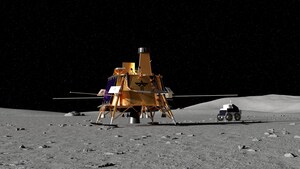WASHINGTON, Feb. 23, 2022 /PRNewswire/ -- Under Artemis, NASA plans to return to the Moon using innovative technologies to explore more of the lunar surface than ever before. This will require lunar surface systems that can deliver continuous, reliable power to support mining and construction, research activities, and human habitation.
The newest phase of NASA's Watts on the Moon Challenge offers up to $4.5 million in prizes to design, build, and demonstrate a prototype that addresses technology gaps in power transmission and energy storage. Maximizing system efficiency and minimizing system mass will be an important part of what the challenge participants address in their designs, given that transporting all the needed equipment to sustain human presence on the lunar surface will require multiple missions. This challenge seeks advanced technology that is well-positioned to progress toward flight readiness and future operation on the lunar surface after the challenge.
"Challenges like Watts on the Moon give us the chance to utilize the creativity of industry, academia, and the public to power our return to the Moon," said Jim Reuter, associate administrator for NASA's Space Technology Mission Directorate at NASA Headquarters in Washington. "I look forward to seeing how their solutions may also have important applications here on Earth and help advance similar technologies for terrestrial application and commercialization."
Phase 1 of Watts on the Moon opened in September 2020 and focused on the ideation of energy management, distribution, and storage solutions. In May 2021, seven winners were awarded a total of $500,000. To compete in Phase 1, teams had to submit ideas to support aspects of a hypothetical mission scenario – harvesting water and oxygen from a dark crater at the Moon's South Pole with energy generated by a power plant located on the crater's outer rim.
NASA invites previous participants as well as new teams to compete in Phase 2.
"We encourage the academic and private sectors to submit entries or even join forces to do so," said Dr. Marla Pérez-Davis, director for NASA's Glenn Research Center in Cleveland. "Here at NASA Glenn, we design, develop, and test innovative technologies to advance NASA's missions in aeronautics and space exploration. As we lead this challenge, we look forward to many innovations to power operations on the Moon and beyond."
Teams can register to compete on the challenge site by 4 p.m. CDT on June 15, 2022. Phase 2 of the challenge will last approximately 30 months and will take place in three segments, called competition levels. In each competition level, eligible teams will submit the required materials and will be evaluated on their submission and scored by the judging panel. Up to seven winners from competition level one will advance to level two and will be awarded part of prize purse up to $1.4 million. Up to four winners from competition level two will advance to level three and will be awarded a part of a prize purse up to $1.6 million. Up to two teams will be recognized as winners in competition level three, where the first-place team will be awarded $1 million, and second place will be awarded $500,000.
The Watts on the Moon Challenge is managed by Centennial Challenges, based at the agency's Marshall Space Flight Center in Huntsville, Alabama. Centennial Challenges is a part of the Prizes, Challenges, and Crowdsourcing program within the agency's Space Technology Mission Directorate. NASA's Glenn Research Center is the lead center for the challenge and is responsible for defining the challenge goals, success criteria, technology, and infusion paths. Centennial Challenges has contracted HeroX to support the administration of this challenge.
For more information about the challenge, go to:
https://nasa.gov/wattson
SOURCE NASA

WANT YOUR COMPANY'S NEWS FEATURED ON PRNEWSWIRE.COM?
Newsrooms &
Influencers
Digital Media
Outlets
Journalists
Opted In





Share this article